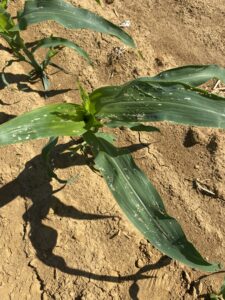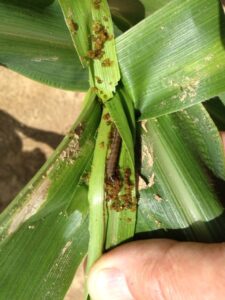Note: The following is a brief description of the pre-harvest water requirements (Section 112.3-112.161) under the Food Safety Modernization Act/Produce Safety Rule (FSMA/PSR). The pre-harvest water requirements are complicated and this summary is intended to be a starting point while we wait for guidance from the Food and Drug Administration (FDA). For those who have already taken the FSMA/PSR grower training we will host an update webinar in the fall. For those who have not taken the FSMA/PSR grower training our course will be updated this year to reflect the latest information.
The pre-harvest water (irrigation, spray water, frost protection, fertigation, dust abatement, etc.) requirements for the FSMA/PSR became effective on July 5, 2024, however this does not mean a grower needed to start complying on that date. Compliance dates are staggered over the next three years depending on the size of the operation. Farms having an inspection in 2024 should expect Subpart E to be discussed by inspectors to prepare them for compliance in 2025 and beyond.:
| Size of Operation | Compliance Dates |
| Operations over $500,000 | April 7, 2025 |
| Small operations (> $250,000-500,000) | April 6, 2026 |
| Very Small operations (> $25,000-250,000) | April 5, 2027 |
It is important to understand what is considered Agricultural Water. Water that is intended to or will likely touch produce is considered agricultural water. In the context of pre-harvest water that means any water you are using for irrigation, frost protection etc. that touches the crop. If you are using drip irrigation for staked tomatoes this is NOT agricultural water as the water is not touching the fruit. If you are using drip irrigation on carrots, this IS agricultural water, as the water is touching the crop. A grower needs to think about how each water source is used before they decide whether it is agricultural water or not. If you have specific questions with regards to whether or not your water is agricultural water, please reach out to us.
Water testing is not a requirement for pre-harvest water but can be part of the agricultural water assessment of the whole water system. This means an inspector will ask the grower to explain their system and how they minimize risks to the covered crops.
Requirements for Inspecting and Maintaining Agricultural Water Systems
As part of the rule, growers must inspect the whole water system (pre-harvest, harvest and post-harvest) at the beginning of the season that is under the farms control. This includes:
- The water source (well and surface); the extent of the grower’s control and how each source is protected.
- Use of adjacent and nearby land (e.g., horse or cattle farm next door; runoff from roads)
- If surface water (e.g., stream, lake, or pond)- what is the chance a food safety hazard could enter the water before it got to your farm? (e.g., dairy farm upstream where cows get in the stream).
An inspection report must be written as to the findings of the inspection!
Requirements for Agricultural Water Assessment
The rule requires that a pre-harvest water assessment must be completed at the beginning of the season, the assessment is different than an inspection!
- The assessment only applies to the pre-harvest water.
- Must be a written assessment dated and signed at the beginning of the season, annually or anytime major changes are made to the system or water source. The inspection report can be incorporated into the assessment.
- Parts of the assessment
- Location and nature of water source (e.g., ground water/wells, surface water/pond, stream, etc.)
- How water is distributed (e.g., underground main, lay flat, canals, etc.)
- How system is protected from contamination (animals, manure applications, etc.)
- Agricultural water practices
- How water is applied and time between last irrigation and harvest
- Crop characteristics (e.g., waxy surface-cabbage, netted surface-muskmelons, etc.)
- Environmental conditions (Damage from frost, hail, blowing sand, etc.)
- Other factors
- Water testing, but the assessment can not be based just on water testing. It is only part of the assessment.
- If the operation meets any of the following, they can be exempt from performing a water assessment.
- No untreated surface water applied.
- Untreated groundwater is tested following the protocol for harvest and post-harvest water (four samples the first year for generic E. coli and one sample every year after if no generic E. coli is found).
- Public water system water use.
- Water is treated, monitored and to be of a safe and adequate sanitary quality.
Outcome from the assessment
- If the water source is not safe or is not of adequate sanitary quality, you must stop use immediately and take corrective measures before use.
- If the problem is related to biological soil amendments of animal or human origin on adjacent or nearby land, mitigation measures to stop and prevent the contamination must be implemented the same growing season (e.g., building a berm around the field to avoid runoff from a horse pasture).
- Any other conditions not related to animal activity impacting the quality of the water must be remediated as soon as practical and no later than the following year. The other option is to test the water source as part of the assessment and implement changes if needed.
Corrective measures are activities that must be done before using the water source. Such as re-inspecting the water system and making any changes or treating the water following FSMA/PSR standards.
Mitigation measures can take many forms including making a repair, increasing the time from the last irrigation to harvest, changing the water application method or source, etc.
Once we receive guidance from the FDA giving us greater details on how Subpart E impacts specific farm scenarios, we will share that information via the Plant and Pest Advisory.



